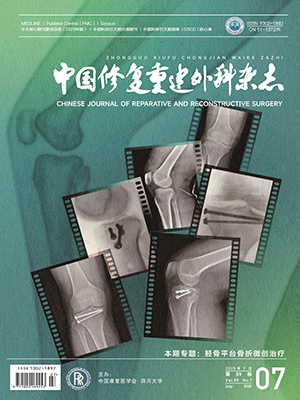【Abstract】 Objective To compare the properties of collagen membranes before and after crossl inked and to establ ish the foundation of appl ication of collagen membranes. Methods Fresh bovine tendons were separated and collagen was extracted by washing, smashing and acetic acid dissolving. The collagen protein was determined by ultraviolet spectrophotometer and its characteristics were analyzed by SDS-polyacrylamide gel electrophoresis (SDS-PAGE), wavelength scanning and amino acids detecting. Collagen membranes were produced by lyophil ization. And then the biocharacteristics of the membranes before and after glutaraldehyde crossl inked were compared. BMSCs separated from volunteer’s bone marrow were seeded on collagen membranes before and after crossl inked by 2×103 in 100 μL medium, seven days after culture, the absorption spectrum of BMSCs was examined, and BMSCs were observed by scanning electron microscope (SEM). Results The contents of collagen protein were 2 mg/mL. The maximum absorption wave length appeared at about 230 nm. SDS-PAGE suggested that molecular
weight of main bands was more than 66.2×103, the same as collagen marker from calf skin. There were 21.47% glycine, 12.04% pral ine and 10.18% hydroxyprol ine. No tryptophan was found. Before crossl inked, collagen membranes were in shape of white sponges and with big holes and the range of pH value was from 4.5 to 5.0. SEM showed reticular conformation and pore structure of collagen membranes, but the bore diameter was bigger. Their water-absorbing capacity was 61 times as much as their weight. The mechanical strength was 210 g/cm3. The dissolution time of collagenase was 90 minutes. After crossl inked, collagen membranes became thin, colorless, semi-transparent and compact with better tenacity. Under SEM, compact collagen fiber appeared reticular. There was lower water-absorbing capacity and pH value ranged from 6.5 to 7.0. The mechanical strength was 3 400 g/cm3 and the dissolution time of collagenase became longer. BMSCs could grow better either on before-crossl inked collagen membranes or on after-crossl inked ones. Conclusion As biomaterial scaffolds, after crossl inked collagen membranes were better than before-crossl inked ones.
Citation: CHEN Lin,LV Yang,GUAN Lidong,WANG Yunfang,He Lijuan,LI Yanhua,BAI Cixian,LIU Daqing,PEI Xuetao.. ANALYSIS OF PROPERTIES OF COLLAGEN MEMBRANES BEFORE AND AFTER CROSSLINKED. Chinese Journal of Reparative and Reconstructive Surgery, 2008, 22(2): 183-187. doi: Copy
Copyright © the editorial department of Chinese Journal of Reparative and Reconstructive Surgery of West China Medical Publisher. All rights reserved




